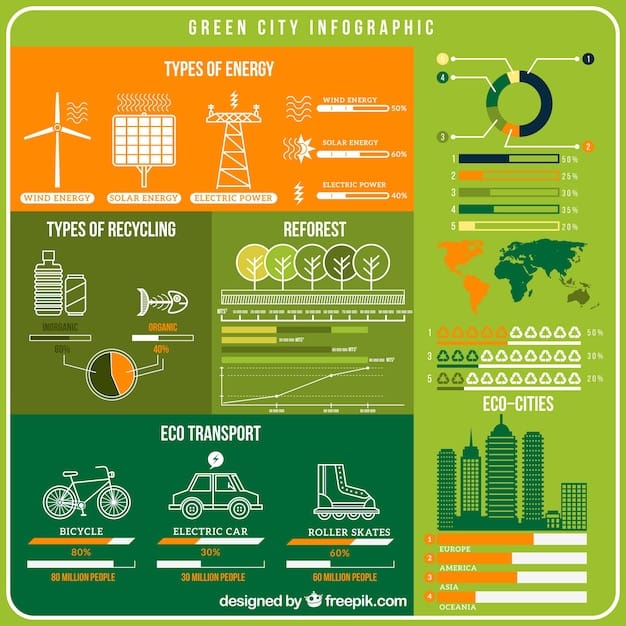Renewable Energy Tax Credits: Maximize Solar Savings by 2025

The Investment Tax Credit (ITC) for Renewable Energy Tax Credits: Claim Up to 26% Savings on Solar Panel Installation Before the End of 2025 allows homeowners and businesses to claim a 26% tax credit on the cost of installing solar panels, providing significant financial incentives to adopt clean energy solutions before the reduction to 22% in 2033 and subsequent elimination for residential in 2035.
Embarking on the journey of solar energy adoption for your home or business can seem like a significant financial investment at first glance. However, understanding the current federal incentives, particularly the Renewable Energy Tax Credits: Claim Up to 26% Savings on Solar Panel Installation Before the End of 2025, reveals a compelling opportunity. This isn’t just about environmental stewardship; it’s a strategically sound financial decision that offers substantial savings, making the transition to clean energy more accessible and rewarding than ever before.
Understanding the Federal Solar Tax Credit (ITC)
The federal solar tax credit, officially known as the Investment Tax Credit (ITC), has been a cornerstone of renewable energy policy in the United States. Introduced in 2005, it has played a pivotal role in democratizing access to solar power, making it an increasingly viable option for a broad spectrum of energy consumers.
Initially set at 30% for both residential and commercial solar installations, the ITC has had a remarkable trajectory, demonstrating the government’s commitment to fostering a sustainable energy landscape. This credit directly reduces the amount of federal income tax an individual or business owes, dollar-for-dollar, based on a percentage of the total cost of their solar energy system. It is not merely a deduction but a direct reduction of tax liability.
Evolution of the ITC and its Impact
The ITC’s schedule of reductions was designed to gradually ease the solar industry into a more self-sustaining phase, while still providing robust support during its growth. By offering a substantial upfront incentive, the credit has enabled countless Americans to invest in solar technology, driving down costs through increased demand and technological advancements. The policy has successfully stimulated economic activity, created jobs, and reduced carbon emissions across the nation.
- 2006-2019: The ITC stood at a robust 30%, fueling rapid growth in solar installations.
- 2020: The credit was reduced to 26%, a slight adjustment but still a significant incentive.
- 2021-2022: Continued at 26%, ensuring sustained momentum for solar adoption despite economic shifts.
The foresight behind tapering the ITC was to allow the market to mature, reducing its dependence on federal subsidies over time. This phased approach has proven effective, as solar power continues to become more competitive with traditional energy sources. The stability provided by the ITC has enabled manufacturers to scale production, installers to refine processes, and consumers to gain confidence in the long-term viability and benefits of solar energy.
As we approach 2025, the 26% tax credit represents the current, highly advantageous window of opportunity. Missing this deadline means a reduction in savings, making the immediate future a crucial period for those contemplating solar energy. The ITC stands as a testament to successful energy policy that balances environmental objectives with economic realities, propelling the US towards a cleaner energy future.
Eligibility Requirements for the 26% Solar Tax Credit
Navigating the requirements for the federal solar tax credit is essential to ensure you can claim these significant savings. Understanding who qualifies, what types of systems are covered, and the key conditions can streamline your application process and maximize your benefit.
Who Qualifies for the ITC?
The Investment Tax Credit (ITC) is primarily available to homeowners and businesses in the United States who purchase and install new solar energy systems. It’s important to differentiate between owned systems and leased ones. Only those who directly own their solar panel systems are eligible; if you lease panels or have a power purchase agreement (PPA), the developer typically claims the credit, not the homeowner. This is because the primary beneficiary of the equipment ownership is the one who can claim the tax credit.
- Homeowners: Individuals who own their primary or secondary residence and install solar panels are eligible. The credit is applied to the individual’s federal income tax.
- Businesses: Companies that invest in solar energy systems for their commercial properties can also claim the ITC. This applies to various business structures, from small enterprises to large corporations.
The property where the solar system is installed must be located in the United States and must be a new installation, not a previously used or relocated system. The intent behind this is to stimulate new clean energy infrastructure development within the national borders.

What Types of Solar Systems are Eligible?
The ITC is not limited to just solar photovoltaic (PV) panels. It encompasses a broader range of solar energy technologies, reflecting a comprehensive approach to renewable energy adoption. This inclusivity allows for various applications depending on specific energy needs and property types.
- Solar Photovoltaic (PV) Panels: These are the most common and widely recognized solar systems, converting sunlight directly into electricity. This includes panels installed on roofs or ground-mounted systems.
- Solar Water Heating Property: Systems that use solar energy to heat water for domestic use are also eligible. However, there’s a crucial caveat: at least half of the energy generated by the solar equipment must be derived from the sun. Swimming pool or hot tub heaters do not qualify under this provision.
- Fuel Cell Property: While not strictly “solar,” fuel cell systems that convert fuel (like natural gas or hydrogen) into electricity through a chemical reaction are also included under certain conditions, such as having a minimum electricity output capacity and efficiency. This part of the credit aims to support diverse clean energy technologies.
- Small Wind Energy Property: Small wind turbines that generate electricity for a home or business can also be included. This broadens the scope for renewable energy generation, especially in areas with suitable wind resources.
- Geothermal Heat Pumps: These systems use the earth’s stable underground temperature to heat and cool homes and businesses, offering significant energy savings and reducing reliance on fossil fuels.
It’s crucial that all eligible equipment is new or newly installed. The system must meet all applicable fire and electrical code requirements, and manufacturers’ warranties should be in place. Furthermore, the cost of labor for onsite preparation, assembly, and installation, as well as piping or wiring to connect the system to the home, are generally included in the total cost eligible for the credit.
Understanding these eligibility parameters is the first step in unlocking the substantial savings offered by the federal solar tax credit. Consulting with a tax professional or a reputable solar installer familiar with these regulations can ensure you meet all criteria and effectively claim your benefits before the 2025 deadline.
Calculating Your Savings: A Practical Guide
Understanding how much you can save through the Renewable Energy Tax Credit for solar panel installation requires a practical approach to calculation. It’s relatively straightforward once you grasp the components involved and the current credit rate.
Total System Cost and the 26% Credit
The federal solar tax credit is calculated as a percentage of the total cost of your solar energy system. As of 2024, this percentage stands at 26%. This “total cost” is comprehensive and includes not only the solar panels themselves but also a range of associated expenses that make the system operational.
- Equipment Costs: This covers the solar panels, inverters, mounting hardware, wiring, and any necessary storage batteries (if installed concurrently with the solar system and charged by it). It’s important to note that batteries purchased separately from a solar system installation might have different eligibility rules.
- Installation Costs: A significant portion of the total cost relates to labor. This includes the cost of permits, inspections, engineering fees, and the actual installation labor for mounting the panels, wiring the system, and connecting it to your home’s electrical grid.
- Sales Tax: In many states, the sales tax paid on the solar equipment can also be included in the total cost for the purpose of the tax credit. It’s advisable to check your specific state’s tax laws to confirm this.
To calculate your potential savings, simply take your total eligible expenses and multiply them by 0.26. For example, if your solar panel installation costs $25,000, your federal tax credit would be $25,000 * 0.26 = $6,500. This $6,500 would directly reduce your federal income tax liability.
It’s important to remember that this is a non-refundable tax credit. This means it can reduce your tax liability to zero, but you won’t receive a refund for any excess credit beyond your tax liability. However, any unused credit can typically be carried forward to future tax years, provided the credit is still in effect. This carry-forward provision is a valuable aspect for those whose tax liability in the installation year is less than the credit amount.
Example Scenarios and Local Incentives
Let’s consider a few scenarios to illustrate the potential savings and how local incentives can play a role:
Scenario 1: Residential Homeowner in Arizona
A homeowner installs a solar system costing $20,000.
Federal Tax Credit: $20,000 * 0.26 = $5,200
Arizona also offers a state tax credit for solar energy devices, which can further reduce the net cost. Coupled with potential property tax exemptions for the increased value due to solar, the overall savings become even more attractive.
Scenario 2: Small Business in California
A small business invests in a $50,000 solar system for its office building.
Federal Tax Credit: $50,000 * 0.26 = $13,000
California has a robust set of solar incentives, including net metering policies and various programs for businesses, all of which would stack with the federal ITC to reduce the effective cost of the system significantly. The ability to depreciate the asset for tax purposes also adds another layer of financial benefit for businesses.
Beyond federal guidelines, many states, municipalities, and local utility companies offer additional incentives. These can include:
- State Tax Credits or Rebates: Direct financial incentives from state governments.
- Property Tax Exemptions: Preventing an increase in property taxes due to the added value of solar panels.
- Sales Tax Exemptions: Eliminating sales tax on solar equipment and installation.
- Net Metering: Allowing you to sell excess electricity generated by your panels back to the grid for credits on your utility bill.
These local incentives can vary widely, so researching what’s available in your specific area is crucial. Websites like the Database of State Incentives for Renewables & Efficiency (DSIRE) are excellent resources for finding these additional opportunities. Combining the federal ITC with state and local incentives can dramatically reduce the payback period for your solar investment, making it an even more compelling financial decision before the 2025 deadline brings changes to the federal credit.
The Urgency of the 2025 Deadline
The window for claiming the maximum federal solar tax credit is closing, emphasizing the urgency for homeowners and businesses considering solar panel installation. The current 26% credit is a significant incentive, but its phased reduction underscores the importance of timely action.
Phased Reduction of the ITC
The Investment Tax Credit (ITC) has a clear schedule for its future reductions, which defines the crucial period for maximizing savings. This phased approach is a deliberate strategy by policy makers to gradually transition the solar industry toward self-sufficiency while still providing a strong impetus for adoption in the near term.
- Current Rate (2022-2025): The credit currently stands at 26% for systems that begin construction by December 31, 2025. This means your system must be installed and operational within this timeframe to qualify for this rate.
- Reduction to 22% (2026-2032): Starting January 1, 2026, the tax credit for residential solar installations will drop to 22% for systems placed in service by December 31, 2032. While still substantial, this represents a noticeable decrease in potential savings.
- Further Reduction and Potential Elimination (2033 Onward): From January 1, 2033, the tax credit for residential solar will decrease to 10%. For commercial and utility-scale projects, the credit will be extended at 30% through 2034, then gradually phases out.
This tiered reduction highlights that delaying your solar installation could result in thousands of dollars in lost savings. The difference between a 26% and a 22% credit on a $25,000 system, for instance, is a $1,000 reduction in your tax credit ($6,500 vs. $5,500). Over larger systems, this difference naturally compounds.
Why Act Now?
There are several compelling reasons to act before the 2025 deadline:
- Maximizing Financial Returns: The fundamental reason is to take full advantage of the highest available credit. Every percentage point matters in an investment of this scale, directly impacting your payback period and long-term financial benefits.
- Avoiding Price Increases: While solar costs have generally decreased over time, consumer demand driven by incentives can sometimes lead to temporary increases in equipment or installation costs. Securing your investment now helps mitigate potential price fluctuations.
- Installation Timelines: Solar panel installation is not an overnight process. It involves several steps:
- Site Assessment: An initial evaluation of your property for solar suitability.
- System Design: Creating a customized solar system plan.
- Permitting: Obtaining necessary local and utility permits, which can sometimes be time-consuming depending on your municipality.
- Installation: The actual physical setup of the panels and electrical components.
- Inspection and Grid Connection: Final inspections and approval from your utility provider to energize the system.
Each of these steps requires coordination and can involve waiting periods. Starting the process well in advance of the 2025 deadline ensures you have ample time to complete the installation and receive approval before the credit steps down. Reputable solar companies often have busy schedules, so securing your spot early is advisable.
- Long-Term Energy Independence: Beyond the immediate financial savings, going solar provides long-term benefits like protection against rising electricity rates, increased home value, and reduced carbon footprint. The sooner you install, the sooner you start reaping these ongoing advantages.
The 2025 deadline isn’t just a date; it’s a financial threshold that could significantly impact your solar investment. Taking proactive steps now ensures you lock in the maximum savings and accelerate your journey towards energy independence and sustainability.
Beyond the Tax Credit: Additional Benefits of Going Solar
While the federal solar tax credit offers compelling financial incentives, the decision to install solar panels extends far beyond this direct saving. Embracing solar energy unlocks a myriad of benefits that enhance personal finances, environmental well-being, and property value, making it a truly holistic investment.
Long-Term Financial Advantages
The most immediate and continuous financial benefit of solar energy is the dramatic reduction, and often elimination, of monthly electricity bills. Once your solar system is operational, you generate your own power, insulating you from the volatility of utility rates and their inevitable increases over time. This predictability in energy costs is a significant asset for budgeting and long-term financial planning.
- Reduced or Eliminated Electricity Bills: Depending on system size and household consumption, many solar owners see their monthly electricity bills drop to minimal connection fees or even zero.
- Protection Against Rising Energy Costs: Utility rates have historically risen. Generating your own electricity hedges against these increases, providing significant savings over the life of your system, which can be 25-30 years or more.
- Increased Home Value: Numerous studies and real estate analyses have shown that homes equipped with solar panels sell faster and at a premium compared to comparable non-solar homes. Solar installations are viewed as valuable, permanent upgrades that offer a desirable feature to prospective buyers.
- Return on Investment (ROI): While the initial outlay for solar can be substantial, the combination of tax credits, reduced energy bills, and increased property value typically results in a positive return on investment within 5-10 years, depending on location and system size. After this payback period, the electricity generated is essentially free.
Environmental and Social Impact
Choosing solar energy is a powerful statement of environmental responsibility, contributing significantly to a cleaner planet and setting a positive example within the community. The environmental benefits are substantial and far-reaching.
- Reduced Carbon Footprint: Solar panels generate electricity without producing greenhouse gas emissions, directly contributing to the fight against climate change. Each kilowatt-hour of solar energy displaces electricity generated by fossil fuels, leading to cleaner air and a healthier environment.
- Decreased Reliance on Fossil Fuels: By harnessing the abundant power of the sun, solar energy helps reduce our dependence on finite and often geopolitically volatile fossil fuel resources. This contributes to national energy independence and security.
- Improved Air Quality: Less reliance on coal and natural gas for electricity generation means fewer pollutants released into the atmosphere, leading to better air quality and public health outcomes, especially in urban areas.
- Sustainable Living: Adopting solar aligns with broader sustainable living principles, encouraging a mindful approach to resource consumption and promoting a greener lifestyle. It fosters a sense of personal contribution to mitigating environmental challenges.
Beyond these direct benefits, the growth of the solar industry creates jobs in manufacturing, installation, sales, and maintenance, boosting local economies. It also fosters innovation in renewable energy technologies, driving further advancements in efficiency and cost-effectiveness.
The decision to go solar is therefore a multifaceted one. While the immediate financial boost from the 26% tax credit is a compelling reason to act before 2025, the compounding benefits of long-term savings, increased property value, and a reduced environmental footprint truly solidify solar as a smart investment for the future.
Navigating the Installation Process and Choosing a Provider
Once you’ve decided to go solar and understand the financial incentives, the next crucial steps involve navigating the installation process and selecting a reputable provider. This phase requires careful consideration to ensure a smooth transition and a high-performing, reliable system.
Key Steps in Solar Panel Installation
The journey from decision to a fully operational solar system involves several distinct stages. Understanding these steps will help you manage expectations and ensure a timely installation, especially with the 2025 tax credit deadline approaching.
- Initial Consultation and Site Assessment: This is where potential solar providers evaluate your property’s suitability for solar. They’ll assess roof size, angle, shading, and structural integrity. They also analyze your historical electricity consumption to design a system that meets your energy needs. This step often includes a preliminary quote.
- System Design and Proposal: Based on the assessment, the installer designs a custom solar system optimized for your home or business. This includes the number and type of panels, inverter selection, and battery storage options if desired. You’ll receive a detailed proposal outlining costs, estimated energy production, and financial savings.
- Financing and Contracts: Once you approve the design, you’ll finalize financing options (e.g., cash purchase, solar loan, PPA) and sign contracts. This is the point where you commit to the project and lock in pricing and terms.
- Permitting and Approvals: Your solar installer will handle the complex process of obtaining necessary permits from your local municipality and approval from your utility company for grid connection. This stage can often be the longest due to administrative procedures and varying local regulations.
- Equipment Procurement and Installation: Once permits are secured, equipment is ordered, and the installation team schedules the physical setup. This typically involves mounting the racking system, installing the panels, wiring, and installing the inverter. The actual installation can often be completed in a few days, depending on system size.
- Inspection and Activation (Permission to Operate – PTO): After installation, your system will undergo inspections by local authorities and your utility company. Once approved, the utility grants “Permission to Operate” (PTO), and your system can be turned on, officially starting to generate electricity and savings.
Choosing the Right Solar Provider
Selecting the right solar installer is paramount to the success and longevity of your solar investment. It’s a significant decision that should not be rushed, as the quality of the installation and ongoing support are crucial.
- Experience and Reputation: Look for installers with a proven track record and extensive experience in your region. Check online reviews, testimonials, and industry certifications. A company’s longevity in the business often indicates stability and reliability.
- Certifications and Licensing: Ensure the installer and their technicians are properly licensed and certified (e.g., NABCEP certification – North American Board of Certified Energy Practitioners). This indicates a commitment to industry standards and best practices.
- Product Offerings and Warranties: Inquire about the brands of solar panels and inverters they use. Reputable installers work with high-quality components backed by strong manufacturer warranties for performance and equipment. Also, ask about the installer’s workmanship warranty.
- Transparency in Pricing and Contracts: A trustworthy provider will offer clear, detailed quotes with no hidden fees. They should explain the full cost, the tax credit implications, and any ongoing maintenance costs upfront. Be wary of overly aggressive sales tactics or vague pricing.
- Customer Service and Support: Assess their responsiveness and willingness to answer all your questions. Good customer service extends beyond the sale to post-installation support, maintenance, and handling any issues that might arise.
- Insurance and Safety: Confirm that the installer has adequate insurance (liability and worker’s compensation) to protect both their employees and your property. A commitment to safety protocols should be evident.
Obtaining multiple quotes from different providers is highly recommended. This allows you to compare designs, costs, product offerings, and customer service approaches. By diligently going through the installation steps and carefully selecting your provider, you can ensure your solar investment is sound and ready to yield benefits for decades to come, well beyond the 26% tax credit window.
Future Outlook on Renewable Energy Incentives
While the focus is currently on the 26% federal solar tax credit expiring in 2025, it’s important to consider the broader landscape of renewable energy incentives as we look to the future. Policy makers are continually evaluating and adjusting mechanisms to support clean energy growth, recognizing its critical role in energy security and environmental sustainability.
Potential Changes and Extensions Post-2025
The scheduled step-down of the federal Investment Tax Credit (ITC) for residential solar after 2025 has naturally led to questions and discussions about what comes next. While a direct, indefinite extension of the current 26% rate is not guaranteed, several possibilities and trends suggest continued, albeit perhaps evolving, federal support for renewable energy.
- Continued Federal Support: There is strong bipartisan support for renewable energy development. While the ITC’s structure may change, the underlying commitment to clean energy is likely to remain, possibly through new forms of tax incentives, grants, or direct funding programs.
- Focus on Manufacturing and Domestic Supply Chains: Future policies might increasingly emphasize incentives for domestic manufacturing of renewable energy components, aiming to strengthen US supply chains and create jobs within the country.
- Performance-Based Incentives: Some policy discussions suggest a shift towards performance-based incentives, such as production tax credits (PTCs) as opposed to investment-based ones. PTCs reward systems based on the amount of electricity they generate, which could encourage higher efficiency and long-term performance.
- Targeted Programs: Future incentives could become more targeted, perhaps focusing on specific technologies (like advanced battery storage), underserved communities, or grid modernization efforts. This nuanced approach would aim to address specific gaps and accelerate particular aspects of the energy transition.
The legislative landscape is dynamic, and future policy decisions will depend on factors such as economic conditions, technological advancements, and evolving energy priorities. However, the general consensus is that renewable energy will remain a strategic priority for the nation, ensuring continued innovation and deployment.

The Role of State and Local Programs
Regardless of federal policy changes, state and local programs are expected to continue playing a vital and perhaps even more prominent role in driving renewable energy adoption. These localized incentives are often tailored to specific regional needs and can be highly effective in overcoming unique barriers to solar installations.
- Net Metering Policies: Many states have robust net metering programs, allowing solar owners to receive credits for excess electricity sent back to the grid. While net metering policies are subject to review and revision, they are a powerful incentive at the state level.
- State Tax Credits and Rebates: States often offer their own tax credits, rebates, or grants that can stack with federal incentives, further reducing the upfront cost of solar. These programs are often designed to stimulate local economies and meet state-specific renewable energy targets.
- Property Assessed Clean Energy (PACE) Programs: PACE programs, available in some states, allow homeowners to finance energy-efficient and renewable energy upgrades through a voluntary assessment on their property tax bill. This mechanism can make solar accessible to a broader range of homeowners by removing upfront cost barriers.
- Community Solar Programs: Increasingly popular, community solar allows multiple subscribers to benefit from a single large solar installation, often located off-site. This is particularly beneficial for renters or those whose homes are unsuitable for rooftop solar. State policies supporting community solar will continue to be crucial.
- Utility Incentives: Local utility companies often offer specific rebates or incentives to their customers for installing solar, aiming to reduce demand on their infrastructure during peak hours and meet renewable energy portfolios.
The decentralized nature of these state and local incentives means that the overall support for renewable energy is not solely dependent on federal policy. This multi-layered approach ensures that even if federal tax credits adjust, a strong ecosystem of incentives will likely remain, continuing to make solar and other renewable energy solutions attractive and accessible for individuals and businesses across the US. Staying informed about both federal and local incentives is key to maximizing your benefits well into the future.
| Key Aspect | Brief Description |
|---|---|
| ✅ 26% Tax Credit | Current federal incentive for solar, reducing tax liability dollar-for-dollar. |
| ⏰ 2025 Deadline | Last year to claim the full 26% credit before it steps down. |
| 💡 Eligibility | Applies to owned residential/commercial systems, including PV, water heating, wind, and geothermal. |
| 🌍 Added Benefits | Reduced bills, increased home value, and significant environmental impact. |
Frequently Asked Questions
▼
The Investment Tax Credit (ITC) is a federal tax credit for solar energy systems, allowing owners to deduct a percentage of the installation cost from their federal income tax. For systems installed by the end of 2025, it’s 26% of the total cost, reducing your tax liability dollar-for-dollar. It’s a powerful incentive to make solar more affordable.
▼
Homeowners and businesses who purchase and install new solar energy systems on their property in the US are eligible. This includes solar PV, solar water heaters, geothermal heat pumps, and small wind turbines. Crucially, you must own the system rather than lease it or have a power purchase agreement.
▼
The 26% federal solar tax credit applies to systems that begin construction by December 31, 2025. After this date, the credit is scheduled to step down. For residential installations, it will be 22% in 2026-2032 and 10% in 2033, making timely action essential to maximize your savings.
▼
Yes, in most cases, the federal solar tax credit can be combined with state, local, and utility-based incentives. These can include state tax credits or rebates, property tax exemptions, sales tax exemptions, and net metering programs. Researching available incentives in your specific area is highly recommended to maximize overall savings.
▼
Yes, battery storage systems are eligible for the federal solar tax credit, provided they are installed in conjunction with a new solar energy system and are charged at least 75% by the solar panels. This increases the attractiveness of adding storage for energy independence and backup power.
Conclusion
The opportunity to claim up to 26% savings on solar panel installation through the federal Renewable Energy Tax Credit represents a pivotal moment for those considering a shift to clean energy. This substantial incentive significantly lowers the upfront cost, making sustainable living more accessible and financially rewarding. As the 2025 deadline approaches, the urgency to act intensifies, ensuring you lock in the maximum benefits before the credit phases down. Beyond the immediate tax savings, embracing solar energy provides lasting financial advantages through reduced utility bills, increased property value, and a significant positive impact on the environment. It’s an investment that pays dividends for decades, contributing to both your personal well-being and a healthier planet. Seizing this opportunity now is a strategic step towards a more sustainable and economically secure future.





